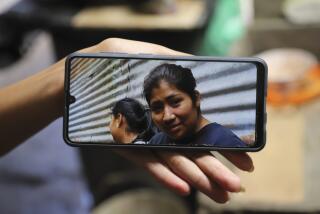Rio de Janeiro’s crack cocaine treatment program controversial
The girl, dazed, disheveled and appearing no older than 12, realized very quickly that she had chosen the wrong time to cross the train tracks running through a favela in Rio de Janeiro.
She refused to give her name or any information to the bulky Brazilian social workers and heavily armed police officers who suspected that she was addicted to crack cocaine and living on the street.
“I’m not going with you. I’m not going anywhere. I’m just going to my mom’s,” she said.
“OK, let’s go talk to your mom then,” said one city worker, flanked by several camera crew members wearing bulletproof vests.
She stopped talking and didn’t budge. When searched, she had nothing but a 5 real bill, worth about $3.
“Let’s take her in,” a social worker said, putting the girl into a van packed with other children picked up that morning. All would be placed into an obligatory treatment program for at least three months.
The girl had stumbled into a new type of “collection” operation carried out periodically in Rio’s cracolandias, or crack lands, which are street communities that attract people of all ages and where drug use is prevalent. Since the raids started in May, more than 1,000 people have been put into confined treatment, including hundreds of children, mostly against their will.
The experimental program is being watched by the rest of the country as a possible model for dealing with Brazil’s persistent problem of child homelessness and drug addiction.
But critics say forcing minors into confinement against their will or the will of their families is unconstitutional. They contend that much of the program is about cleaning up the streets of Rio de Janeiro, which is preparing to host the World Cup soccer tournament and Olympic Games.
Similar programs run on a voluntary basis have long been available, but until recently forced internment for treatment was illegal and it remains so in the rest of the country. This year, however, the city of Rio found a way to reverse the law locally, arguing that minors addicted to crack cocaine don’t have the mental capacity to exercise the right to accept or deny treatment.
“What was being done before just wasn’t working,” said Rodrigo Bethlem, secretary for social services for Rio de Janeiro, who oversees the program. “I believe very strongly in the legality and the importance of this work. At times like this, I think what I would want done if it were my child. We can’t think of doing it another way.”
Despite an economic boom accompanied by an expansion of social services that has lifted tens of millions of people out of poverty, Brazilian society remains extremely unequal, with large homeless settlements in many communities. These places are colloquially known for their crack use, but also prevalent is the drug “oxi,” a cheaper, more dangerous derivative of cocaine usually made with gasoline.
In Sao Paulo, Latin America’s financial capital, a cracolandia can be found just blocks from the stock exchange, now among the world’s largest.
As authorities monitor the new program in Rio, experts in Brazilian jurisprudence debate people’s right to refuse treatment to the right of others to move freely through the city center.
The Order of Brazilian Attorneys has declared the program in Rio to be unconstitutional, saying it violates the rights of the children.
“Children and adolescents are subjects, with rights, and they should be respected as citizens and not collected like human trash,” wrote Judge Siro Darlan, who says the state should create programs to ensure that children don’t end up on the streets in the first place.
“Of course no one wants children using drugs, but the real crime was to leave them without families, without schools, without respect, walking the streets because [the government] lacks the means to treat them with dignity.”
Workers carrying out the Rio program clearly know that many people in the communities they visit do not welcome their presence.
“We send in the police before us to set up a perimeter, because these communities are very dangerous and sometimes hostile,” said Ana Paula Domingues, communications coordinator for the city’s social services office. “Sometimes the kids attack the social workers, or sometimes the threat is from elsewhere.
“Once, someone launched two grenades at us, and that of course slowed down the operation.” No one was hurt in that incident.
Because the police are involved, carrying out the program can take on a harsh edge. In the favela, or slum, of Jacarezinho, officers carried off several motorcycles under the assumption that they had been stolen.
“We don’t have proof, but it’s probably stolen. It’s all beat up and missing the plates,” said one officer, despite the loud protests of the man living in the house where the bike was parked.
“We hate these people,” said Tiago, a 24-year-old resident of the neighborhood, who watched from the sidelines. “They just come in with the police and mess with us. They’re here to clean things up for the gringos. It’s sad the state these kids live in, but they’ll all be back here in no time.”
The social workers pick up more adults than children, but the adults are free to leave treatment whenever they want and often do so quickly. Children must stay.
Recently, the city set up Casa Viva, a bright blue house in the leafy neighborhood of Laranjeiras, where children ages 8 to 15 live and receive treatment. Sandy, 12, and Adriely, 14, say they want to get through the program and make something of their lives.
“I ran away from home years ago because I was beaten,” Sandy said. “I want to be a judge when I grow up.”
Yet Claudia de Castro, a social worker at Casa Viva, is under no illusion about what most of the kids there desire.
“The majority are desperate to leave, now. We’ve taken them from what they know, their lives, their friends,” she said. “But we’re trying to give them a better option. Here they get education, and all kinds of medical and psychological treatment because we aren’t just talking about drug addiction. Some have AIDS or other diseases, some have dementia or psychosis.”
Once the children are judged fit to leave the shelters, the city tries to find a family member considered responsible enough to raise them. This is not always possible, so many children are placed with foster families that receive 300 to 500 reals a month to raise them.
“It’s not easy for us to go into these communities, because of all the resistance we encounter, and because this program is new and we’re still not entirely sure what will happen to the children after they finish it,” said Daphne Braga, a social worker.
“We just really hope we’re doing the right thing for these kids.”
Bevins is a special correspondent. Alexander Houghton, also a special correspondent, contributed to this report.
More to Read
Start your day right
Sign up for Essential California for news, features and recommendations from the L.A. Times and beyond in your inbox six days a week.
You may occasionally receive promotional content from the Los Angeles Times.






